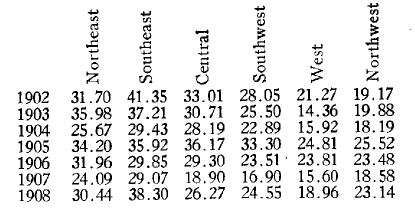|
|
THE GRASSHOPPER PLAGUE
|
667
|
ground well twice, then harrowed it, and next rolled it
with a heavy roller. His corn that year yielded fifty
bushels to the acre.
The premium list of the Otoe Agricultural
Society, published in the Nebraska News, September
28, 1858, offers a premium for the best five acres of fall
wheat and a diploma for the best five acres of spring wheat.
The Nebraska City News, of March 9, 1861, says that
"the winter wheat in this section looks fine." The editorial
opinion was that the heavy snows of the winter had kept it
warm, and it was ready for a strong start. The Nebraska
Advertiser, of July 4, 1861, says that some Nemaha
county farmers harvested forty bushels of wheat per acre
that year. The hot, dry weather in June injured spring
wheat. In "the various parts of the territory fall wheat has
produced much better than spring, not only this season, but
for the past three years. We cannot understand the cause of
the prejudice in the minds of many farmers against raising
fall wheat." The same newspaper, of October 18, 1862, said
that fall wheat that year yielded one-third more than the
spring variety in Nebraska, and that its average for the
last five years had been higher than that of spring
wheat.
The Daily State Journal, September
28, 1878, put the yield of fall wheat that year as 268,532
bushels; 45,370 bushels in the North Platte section, and
223,162 bushels in the South Platte. The yield of spring
wheat for that year was 10,752,668 bushels in the South
Platte and 5,471,527 bushels in the North Platte.
Dr. George L. Miller usually threw the
whole power of his enthusiasm into his advocacy of any
Nebraska enterprise, and the final recognition of this grain
as one of the most important crops in Nebraska is largely
due to his persistent preaching in its favor. The
Herald (weekly) of August 10, 1870, says that this
crop had "hitherto been a failure," because it had winter
killed. The editor -- Dr. Miller -- advocated deep planting
as a remedy and suggested drilling in the wheat. This method
of planting was generally adopted later, and was apparently
a condition precedent to the successful cultivation of the
grain in question. The Omaha Daily Bee, of October 3,
1892, remarks upon the growing importance of fall wheat. The
state was now producing 18,000,000 bushels a year, and the
Bee expressed the opinion that the yield might reach
100,000,000 bushels. There was a sudden increase in the
production about 1880 and a still larger increase about
1900. According to the records of the department of
agriculture at Washington, the average annual yield for the
period of 1870 to 1879, inclusive, was 5,372,559; for the
period 1880-1889, inclusive, 18,608,697; 1890-1899,
18,560,914; 1900-1909, 43,378,151. According to the
estimates of the Nebraska labor bureau the yield in 1906 was
45,389,263; in 1909, 46,444,735. In the last two years the
yield has not held its own on account of drought conditions
in a part of the state.
The Rocky Mountain locust during the three
years from 1874 to 1876 threatened the practicability of
carrying on agriculture in Nebraska, inasmuch as there
seemed to be plausible reason for fearing, if not believing,
that the invasion by this pest might be continuous. A
thorough acquaintance with the history of Nebraska, however,
would have largely allayed this fear because it discloses
that the immigration of these insects was not regular but at
periodical intervals. In his famous Ash Hollow campaign of
1855, General William S. Harney and his command, when in
camp near Court House Rock, now in Morrill county, observed
that the air was full of grasshoppers; and they were ail
inch thick on the ground. Of course they destroyed "every
blade of grass." W. A. Burleigh, in his report as agent for
the Yankton Indians for 1864, says that crops were promising
in that part of the country until the grasshoppers came in
the latter part of July and destroyed every vestige of them
throughout the territory. The air was filled with the
insects so thickly as to produce a hazy appearance of the
atmosphere, and every tree, shrub, fence, and plant was
literally covered with them. In many places they carpeted
the ground to the depth of from
|





